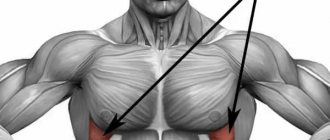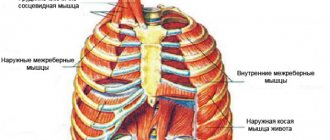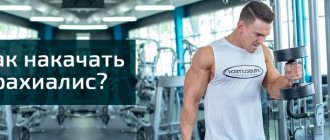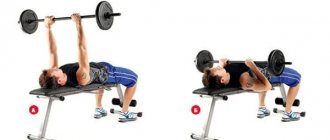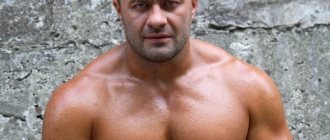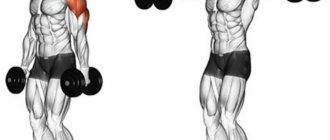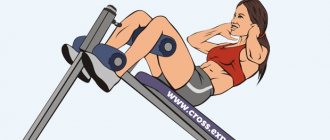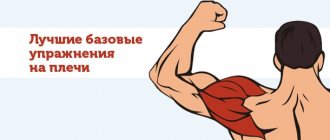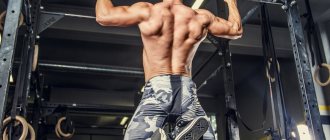Fitness programs almost always lack exercises for the serratus anterior muscle. From the point of view of working out all muscle groups, it is not so large as to add separate exercises for working out. However, from an anatomical point of view, the serratus anterior muscle performs important functions, and therefore needs training no less than other muscles. Also, with sufficient hypertrophy and a low percentage of subcutaneous fat, it allows you to create an excellent athletic appearance, emphasizing the relief of the chest and abs. Prominent serratus muscle has become a hallmark of many athletes, so devoting sufficient attention to training it will bring you a number of benefits.
Anatomy and location of the serratus anterior muscle
Serratus anterior muscle location
The serratus anterior muscle has a flat structure. It is quite wide, and its distinctive feature is the “teeth”, which is how it got its name. The location of the serratus muscle on the chest is the anterolateral section of the chest wall.
The upper part is covered by the pectoralis major, so only a small part of it can be visually assessed. Moreover, it is this part that lends itself best to hypertrophy (that is, when performing exercises on the serratus muscles, only by this part can you visually assess progress).
The muscle starts from the I-IX ribs, moving backwards and upwards. It covers the ribs along an arc, from 8-9 teeth of the ribs to the tendon arch between the I-XI ribs. Attaches to the ventral surface of the medial part of the scapula (between the lower and upper corners).
Anatomically there are three parts:
- Superior – located in the area of 1-2 ribs.
- Intermediate – located in the area of 2-3 ribs, with a shift towards the scapula.
- Inferior - the largest bunch, from 4 to 9 ribs. It is considered the strongest part (when it comes to training the serratus muscles and hypertrophy, this is what they mean).
Start and Attachment
The PSM originates on the anterior surface of the eight or nine upper ribs and is inserted on the medial border of the scapula.
We recommend reading: Why with; is nausea during exercise and what to do about it
Conventionally, this muscle is divided into three parts:
- Upper: 1st-2nd rib → upper corner of the shoulder blade.
- Middle: 2nd to 3rd rib → medial edge of scapula.
- Inferior: from the 4th to the 9th rib → medial edge and lower angle of the scapula. This is the most powerful and outstanding part.
Innervation and blood supply
The PZM is innervated by the long thoracic nerve (C5-C7 roots of the brachial plexus). The blood supply to this muscle is provided by the lateral thoracic, superior thoracic and thoracodorsal arteries.
Functions of the serratus anterior muscle
The main function of the serratus anterior muscle is to abduct the shoulder blades. The main antagonist is the trapezius muscles. Muscle functions, depending on the bundle:
- Moving the scapula forward and laterally (mainly the lower angle).
- Rotation of the scapula around the sagittal axis to lift the arm above the horizontal level (lower fascicles).
- Raising the ribs with a strengthened scapula (promotes expansion of the chest).
When the muscle is weak and underdeveloped, a “pterygoid scapula” is formed. The function of shoulder abduction and flexion also becomes more difficult and worsens.
The structure of muscle fiber and the mechanism of muscle function
A muscle fiber is a single cell with thin (actin) and thick (myosin) filaments surrounded by mitochondria. The threads are able to interact in small areas of the fibers, this space is called a sarcomere and in total makes up 30% of the length of the muscle fiber, so the muscle can only shorten by 30% of its length. Outside each fiber there is a feeding capillary and a nerve cell process (motoneuron axon); at the point of “connection” to the nerve cell there is a tank containing calcium ions.
The mechanism of muscle contraction (sliding filament theory 1954): at rest, the interaction zone is filled with “brake fluid” - magnesium ions (Mg2+), which allows you not to waste energy at rest. When an exciting impulse passes, calcium ions leave the tank into the interaction zone and remove the “brakes” from actin filaments and activate the centers of myosin molecules, after which contraction occurs. After stimulation ends, calcium returns to the tanks and relaxation occurs.
During muscle work, glucose (glycogen) and fatty acids act as an energy source with sufficient oxygen concentration. Muscles are capable of storing adenosine triphosphate (a source of energy), but these reserves in the muscle are only enough for eight single contractions. To resynthesize ATP, the body uses reserves of creatine phosphate - an energy storage and transmitter from mitochondria to acto-myosin complexes.
Human musculoskeletal system. The growth and development of muscles and bones are closely related - bones are a fulcrum and storehouse of calcium for muscles, and muscles, in turn, regulate the nutrition and growth of bones up to 25 years in length. The muscle is attached by a tendon to the periosteum and, when contracted, stretches it, creating a “subperiosteal space”, the metabolic processes in which are much more intense. This allows the cells to build bone beams more quickly and efficiently, and as a result the bone grows in thickness. This is the main mechanism for strengthening bones, explaining that it is impossible to achieve results only by increasing the concentration of calcium in the blood without accompanying muscle work.
Features of the training
In fitness, there are no secret exercises to pump up your serratus muscles. They are involved in most movements that are aimed at developing the pectoral, deltoid and back muscles. The muscle is also partially involved in some abdominal movements. Therefore, you can often come across the wording “serratus abdominal muscles” (although anatomically it is not correct).
The main problem on the way to pronounced hypertrophy of the desired muscle is its function. It is very difficult to perform a movement in which the rest of the muscles do not take on the entire load. This requires special conditions when performing exercises, as well as carefully selected weight (mostly the work is carried out with light weights).
The main sports in which this muscle is involved:
- Strength sports (bodybuilding, weightlifting, powerlifting).
- Swimming (works in all styles and techniques).
- Disciplines where there are throwing and pushing elements.
- Artistic gymnastics (while holding on rings, uneven bars, etc.).
- Martial arts and other sports in which the shoulder girdle is actively involved.
In most disciplines, the muscle develops naturally. You should pay attention to pumping up the serratus anterior muscle only if it is clearly lagging behind, which leads to worse results in sports.
Therefore, the main sport in which muscles are trained to increase volume is bodybuilding. Mostly we are talking about a competitive career, where the form can give an additional advantage and give aesthetics to the figure in some positions.
It is also worth noting that the pronounced serratus muscle in professional bodybuilders is largely the result of competent posing than targeted development. Genetics also plays an important role, which determines the shape (for some athletes it stands out noticeably even without additional exercises).
Types of human muscles (types of muscle tissue)
The human body consists of three types of muscle tissue:
- Smooth muscles - form hollow organs, such as the digestive tract, bladder, blood vessels.
- Cardiac (myocardium) - the muscle pumps blood into the arteries.
- Striated – Skeletal muscles perform movement and make up the majority of the muscular system in the human body. It is these muscles that perform the motor function necessary not only for training, but throughout life. Let's take a closer look at skeletal fibers.
Table 1. Types of skeletal muscle fibers.
| Peculiarities | Slow (tonic) | Fast (phasic) |
| Structure | Lots of mitochondria. Reds have a developed energy-producing apparatus that oxidizes carbohydrates and fatty acids. | Few mitochondria. Whites are more inclined to store ATP and creatine phosphate, after their consumption they support energy exchange by oxygen-free glycolysis. |
| Location | In the deep muscles. Extensor and abductor muscles. | Superficial muscles. Flexor and adductor muscles. |
| Excitability | Pulse speed = 2-8 m/s. They are excited slowly and heavily - they require long-term and strong external stimulation (“nervous enhancement”). They have great accuracy. | Impulse speed = 8-40 m/s. They get excited quickly. Contraction is 3 times faster than slow fibers. |
| Energy exchange | Capable of actively using oxygen in glycolysis for the oxidation of reserve carbohydrates and fats. They regulate heat exchange well. A balance is established between work and need. | An oxygen debt quickly builds up. Prone to anaerobic processes using glycogen. They overheat quickly. They are adapted to energy deficiency and can work for some time without a sufficient supply of oxygen. |
Top 5 exercises to train the serratus anterior muscle
Despite the fact that the serratus anterior belongs to the back group (according to its function), the area is used primarily in exercises for training the pectoral. The most effective movements for loading are:
- Pullover with a dumbbell (movement number 1 to pump up the serratus muscles) .
- Bench press (on a flat or incline bench, also with a downward incline press).
- Standing presses with dumbbells or barbell.
- Breeding with dumbbells in a lying position (on a horizontal or inclined bench).
- Pull to the chin (“broach”).
Deep back muscles[edit | edit code]
Deep back muscles, lumbar region[edit | edit code]
- Iliocostal lumbar muscle
- Intertransverse lumbar muscles
- Low back rotator muscles
- Multifidus lumborum muscle
Deep back muscles, thoracic region[edit | edit code]
- Iliocostal muscle of the chest
- Longissimus thoracis muscle
- Spinalis thoracis muscle
- Rotator muscles of the chest
- Multifidus chest muscle
- Semispinalis thoracis muscle
Deep back muscles, cervical region[edit | edit code]
- Iliocostal muscle of the neck
- Longissimus capitis muscle
- Longissimus colli muscle
- Splenius neck muscle
- Splenius capitis muscle
- Spinalis neck muscle
- Spinalis capitis muscle
- Rotator neck muscles
- Multifidus neck muscle
- Semispinalis neck muscle
- Semispinalis capitis muscle
- Rectus capitis posterior major muscle
- Rectus capitis posterior minor muscle
- Superior oblique capitis muscle
- Inferior oblique capitis muscle
Correct technique for performing each exercise
Before training, do not forget to warm up and pre-stretch!
Barbell bench press
We will need an incline bench, barbell racks and the barbell itself. The exercise can be done at home. Here the weights are not as heavy as in the case of the classic bench press.
The first approach will be a warm-up with an empty bar (its weight is about 20 kg - for girls this is a lot, for guys it’s just right):
- Set the inclination of the bench back to 30 degrees. We lie down so that the barbell is exactly above our eyes.
- We grab the bar with our hands wider than our shoulders. The grip width is determined as follows: lower your arms from this position with your elbows down, the angle between the forearm and shoulder should be about 90 degrees. The grip is circular, there is no need for any one-sided grips where the bar could roll onto your stomach.
- We rest our feet on the floor. Raise the bar to the maximum possible straightening of your arms and lower it onto your neck. It was a breath.
- As you exhale, return it to the top point. Do 15 reps with an empty bar, then begin working sets.
If you are a girl, take a lighter bar. For you, dear ladies, there will always be bars weighing 4, 6, 8 kg, etc. They are rubberized and multi-colored.
The nuances that cause errors to occur:
- Do not lift your pelvis during the exercise. He is “glued” to the bench.
- The chest is slightly curved forward, there is a natural deflection in the lower back. There is no need to do any bridges, otherwise you will turn your body into the classic press position. The meaning of the tilt is lost.
- The legs are spread and the heels rest on the floor. It happens that beginners, having watched enough strange video tutorials on “how to build muscles,” keep their legs suspended. At any moment they can fall to one side of the bench. We understand that they also want to pump up their abs, but this is done separately. Without a barbell.
- We perform it smoothly, without jerking.
- Lower the barbell to the neck area. Not on the chin or chest. It is important for us to work the upper part of our pectoral muscles!
- We don’t take our heads off the bench. We look up, not left and right.
- Always lock the barbell. If during training the pancake falls or slides onto the edge of the bar, the approach will be wasted.
We select the working weight so that it is hard to work, only in this case we will be able to pump up something. We do this version of the exercise after the classic bench press, or on our own - 3-4 sets of 8-10 repetitions. We approach working weight gradually. If necessary, we call a partner to back up.
Dumbbell flyes
We set the same angle of the bench. We lie down on it in the same way as when doing a barbell press:
- The movement of dumbbells occurs in a plane perpendicular to the floor. Elbows point down.
- We stretch as much as possible, lowering our arms with dumbbells.
- The arms are slightly bent during the movement and almost straighten at the top point (there is no need to bend them to 90 degrees; you cannot do the exercise with straight arms).
We spread our hands as we inhale, and bring them together as we exhale. The weight should be such that you can do 3 sets of 12 reps with correct technique.
Dumbbell press
This is where disagreements arise. Some trainers suggest doing the same thing as with a barbell, but with dumbbells. Others say that you need to move your elbows a little closer to the body to increase the load on the front deltoids.
We offer a compromise: Move your elbows a little closer to your body from your angled bench press position. We do 3-4 sets of 10 times.
Bringing hands together in crossover
Perhaps the most technically difficult exercise:
- We install the necessary handles so that it is comfortable to hold with your hands.
- We stand between them. We take the handles with our palms forward and bring them together on slightly bent arms at chest level.
- Here is the nuance - if you lower your arms, it will no longer be the top of the pectoral muscles that will work.
- Your hands should be slightly behind each other at the final point of reduction, as if you had crossed them.
The exercise is a little easier than the version with dumbbells, so here you can perform a little more repetitions - 3-4 sets of 10-12 times.
Dips
The warm-up approach should be without weight. If possible, move the bars so that the distance between them is about 10 cm wider than your shoulders on each side.
The nuance is this: when doing push-ups, we do a “boat”. That is, we tilt our legs back. When moving from bottom to top, you seem to emerge from under the water. This will shift the load from below to the middle of the chest.
We do 3-4 approaches of 15 times without weight or the same number of approaches, but 8 repetitions with weights. If desired, you can make a ladder, reducing the number of repetitions from approach to approach, and increasing the weight.
Upside down push-ups
The most convenient option for breast lifting at home. Take a stool or sofa. We take a lying position, hands slightly wider than shoulders, fingers pointing forward. We put our feet on a stool.
This way you are standing in an inclined position. Head below feet. We do 3-4 sets of 10-15 times. If you can do more, do it. It doesn’t matter, it’s still without any burden.
We go down as we inhale, we rise as we exhale. Our chin almost touches the floor.
Classification of muscles of the human body
The shape of the muscles differs into:
- long;
- short;
- wide.
According to the direction of the fibers, muscles are divided into:
- with parallel fibers - long, fusiform and ribbon-shaped muscles;
- with cross fibers;
- with oblique fibers - single-pinnate, bipinnate.
According to their position in the body they are divided into:
- superficial;
- deep;
- external;
- internal;
- medial;
- lateral.
Functional muscle groups during limb movement:
- flexors;
- extensors;
- diverting;
- adductors;
- pronators;
- arch supports.
Regarding the movement of the body, there are:
- flexors;
- extensors;
- tilting (right - left);
- twisting (right - left).
Also, according to the type of interaction during movement, muscles are conventionally distinguished:
- Agonists are muscles that perform the main work of a given movement (main muscle).
- Synergists are muscles that help the main one to carry out a given movement.
- Antagonists are muscles that oppose a given movement.
- Stabilizers (fixator, neutralizer) are muscles that maintain balance and safe position of joints during movement.
Read more about muscles agonists, synergists and antagonists →
Exercises to pump up the upper chest
To pump up your upper chest, you need to learn 6 exercises:
- Bench press at different angles.
- Dumbbell raises at 30 and 45 degree angles.
- Press dumbbells at the same angles.
- Bringing your arms together in a crossover (arms above parallel).
- Dips. This exercise is more focused on working the lower chest and outer part, but don't let that fool you. We will do it, as it is very effective for complex muscle development.
- Push-ups from the floor upside down.
